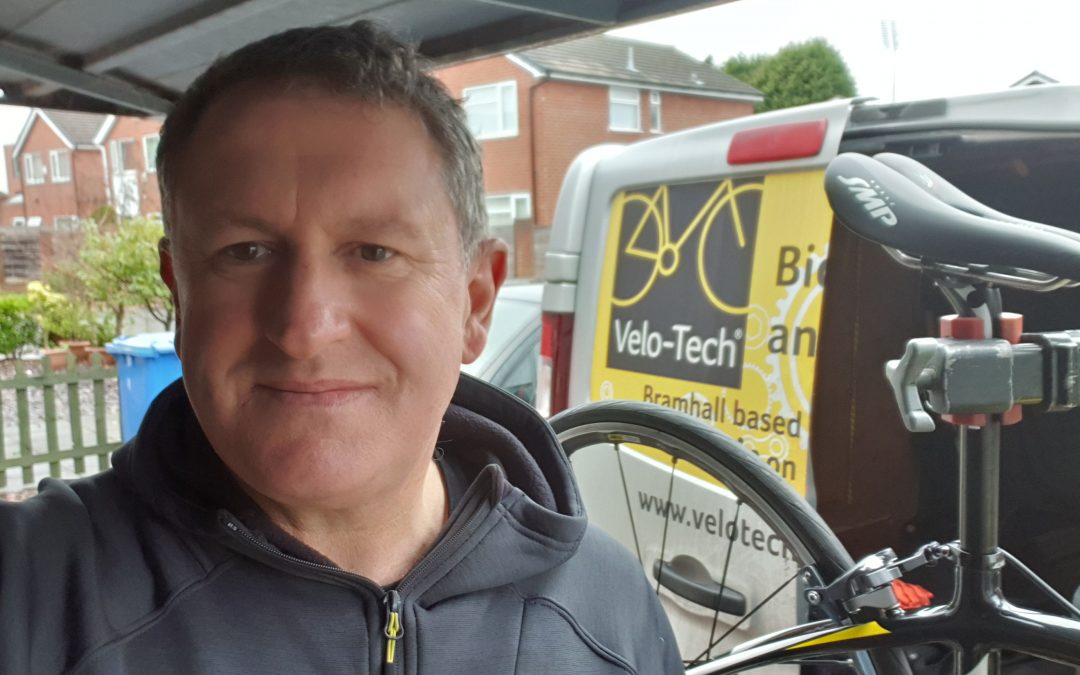Blog

Stay safe on your bike! How to do some basic safety checks
Our current locked-down lives, quieter roads and one form of outdoor exercise a day is encouraging lots more people to get out on their bikes – which is great to see! While this includes many brand-new bikes, we are also seeing a lot of bikes being dusted off from the garage or the shed that may not have seen the light of day for some time. For those of you bringing your bikes out of hibernation, here are some hints and tips on how to check your bike over to keep you safe and getting the most out of your cycling.
- How old are your tyres? – If your bike hasn’t been used for a while and has been kept with the tyres deflated tyres, even for as little as 6 months, they may have become cracked or perished and will need replacing. If the tyre quality is looking good, make sure that they are inflated to the correct pressure level – this can be found on the side wall of every tyre.
- Are your brakes working effectively? Once you have your bike moving, the most important thing is that you can actually stop. To check the brakes are stopping the wheels effectively when you pull the brake leavers, simple roll the bike gently forward and pull the front brake first. If the back of the bike rises off the ground, then your front brakes are functioning well. Repeat this in the opposite direction with the rear brakes, if the front of the bike rises off the ground then you’re good to go!
- Check all your cables – Check both your gear and brake cables and make sure they are not frayed along their length, especially where they attach to the brake callipers and gear mechanisms. If they are damaged, we would recommend changing them as soon as possible as they could pull through the pinch bolts. If this happens at best you may not be able to change gears, at worse you may not be able to stop!
- Turn your wheels – Make sure your wheels are not buckled and there are no snapped spokes. If you spin the wheel and there is any side-to-side movement this could mean that there is a buckle in your wheel. A buckled wheel will affect your ability to ride and could eventually start rubbing against the bike frame.
- How does your chain look? – Make sure your chain isn’t rusted and when you turn the pedals make sure all of links are running smoothly through the gears. A rusty chain won’t get you very far and is likely to cease up or snap as you are riding along.
KPMG National Charity Bike Ride: Bike Choices
In this first blog we are going to explore the different bike choices and what will be best for completing the ride.
It may be some time since you last rode a bike and the thought of completing the challenge may seem daunting, but with some forward preparation the miles will fly by.
So which bike should I choose?
Mountain Bike
 Firstly, on most of the days a mountain bike just isn’t going to be an efficient means of getting from A to B. The frame weight, geometry and the width and normal tread pattern of the tyres create far too much resistance and will severely hamper your speed and enjoyment.
Firstly, on most of the days a mountain bike just isn’t going to be an efficient means of getting from A to B. The frame weight, geometry and the width and normal tread pattern of the tyres create far too much resistance and will severely hamper your speed and enjoyment.
We have experienced, very capable mountain bikers undertaking various road based routes/ challenges of the distances you will be undertaking and they have all been unable to complete the full ride.
So, that leaves hybrid or road bikes:
Hybrid
 A hybrid gives you a lot of the benefits of a road bike (gearing, weight, wheel size) in a, usually, less prone position, so if you’re not a fan of road bike ‘drop’ handlebars, the straight handlebars of a hybrid may be for you.
A hybrid gives you a lot of the benefits of a road bike (gearing, weight, wheel size) in a, usually, less prone position, so if you’re not a fan of road bike ‘drop’ handlebars, the straight handlebars of a hybrid may be for you.
One point to note is that, generally, hybrid tyres are normally a lit
tle wider (28-36mm) than equivalent road tyres (25-28mm) and generally have more tread, so one means of creating a more efficient ride is to invest in tyres with less tread (slicker), which will ensure a smoother, quicker ride. Less tread and slicker doesn’t mean less grip or more punctures, modern, quality tyres have excellent grip and puncture protection as standard – we will cover tyre choices and set up in a later post.
Road
 The are several advantages of a road bike. They are designed to cover great distances efficiently and are generally of a lighter design (frame, wheels etc). There are usually greater gearing options to cover all eventualities, and little fixes, such as changing handlebar tape to extra thick, which all adds up to a more comfortable overall experience.
The are several advantages of a road bike. They are designed to cover great distances efficiently and are generally of a lighter design (frame, wheels etc). There are usually greater gearing options to cover all eventualities, and little fixes, such as changing handlebar tape to extra thick, which all adds up to a more comfortable overall experience.
Once set up correctly, a rider on a road bike should be able to cover many miles in comfort and with no pain – if you’ve been training!
Where to buy?
The internet is awash with cheap bikes, but, unless you already know the exact size you require it can be somewhat hit and miss.
Any reputable local bike shop, should be able to assess your needs and advise on the exact size of frame required and set you up on the bike to ensure you are in the most comfortable, efficient position and advise on accessories required to keep you cycling.
Diary of a Sportive Support Day
Saturday 25th April 2015 – ITP events Rutland Sportive
This was the second event I had supported for ITP events having been introduced by Neil Exton of AGU mobile bicycle repairs – one of my tutors I met while undertaking my City and Guilds. (My efforts at last years Lincoln Grand Prix sportive must have been noticed as Ian Penrose had asked me back to cover this and the Lincoln Sportives).
ITP events are always extremely well organised, well received and with good turnouts. This event was no different and an excellent field of 1030+ riders meant that our time would be fully occupied. Thankfully the weather (apart from the wind) wouldn’t be a major factor as the day was bright with broken cloud and sun.
An early 7am start at Rutland Water and no hanging about – straight into helping build one of the many gazeebos that adorn the start/finish line.
After a briefing between Neil, his son Paul (who would be covering the course on his motorbike) and myself, the plan for the day was decided. Neil would set out about 30 minutes after the first long route riders had set off then Paul after 45 minutes and myself after an hour. This ‘staggering’ of departures allows us to deal with any issues that may arise on all the routes and not be too far into the course to be able to deal with issues nearer to the start.
But before that it was time to set up the work stands at the start and deal with any last minute adjustments or issues before the riders set off.
The most frequent request?
To use our wire cutters to remove the tag from the end of the cable tie for attaching the rider number!
There were other issues with minor adjustments to gears (and subsequent advice on drivetrain servicing and cleanliness……), to re-truing a wheel with a number of loose spokes, and the most bizarre – a very noticeable front wheel click on a very expensive set of carbon wheels, only under load, and every revolution. After a little head scratching and both Neil and myself looking at it, it was narrowed down to an ill-fitting valve; a tightening of the locking ring saw the end of the noise.
After setting off following the field it wasn’t long before I received my first call from control to attend one of two rear mech. hanger issues, the first was an end to the riders event as the rear mech. had pulled completely over the top of the cassette jammed in the wheel and as the rider had come off the bike the rear wheel rim had snapped. The second was recoverable but only back at the Giant Cycle store, where a new rear mech. and mech. hanger enabled him to resume the short route.
And most unusual…
The next was an unusual call – a lady had torn her tyre and needed a replacement – nothing too unusual in that but the tyre had split both sides all the way around the rim. After changing the tyre and replacing the wheel, it was obvious that the wheel was not sitting correctly – a quick check revealed that the quick release retaining springs were the wrong way round and the resultant 2-3mm had caused the brake pads to wear through the tyre after only a few miles.
Keeping in constant communication with Neil, Paul and control we co-ordinated our movement around the route to ensure we kept up with the riders and kept the whole route within easy reach.
The last major incident I had to deal with was a snapped chain, on a virtually brand new Giant bike fitted with 11 speed Ultegra gearing – the chain had snapped on the link pin (I really do not like these and this is the 3rd chain on an 11 speed groupset that I have seen snap in this manner – a ‘chain link’ is far more reliable). After fitting a chain link and straightening out the front mech. the rider was on his way once again.
The rest of the event passed with only minor issues and gave me time to appreciate the rolling countryside of Leicestershire before it was time to find the last rider on the road and ensuring no one was left out on the road. Ian from ITP Events doesn’t set a time limit on completion allowing the riders to ride at their own pace, so it was time for a run around the route between us all until the last rider was located on the road and a convoy of mechanics and broom wagon shepherded the riders to the finish.
My time was done and another day of forward planning and constant communication had ensured that the sportive was relatively uneventful, thanks of course to Neil, Paul and Ian and the ITP team.

CALL MARTIN ON: 07929 892429
As well as helping to keep your bike in top condition, I’m also keen to help you get the most out of your cycling.
If you’re truly passionate about your bike, why not consider having a bespoke bike built to your exact specifications? See some recent bike builds can be found on our Bike and Wheel Building page – there’s even some stunning retro bike builds amongst them!
